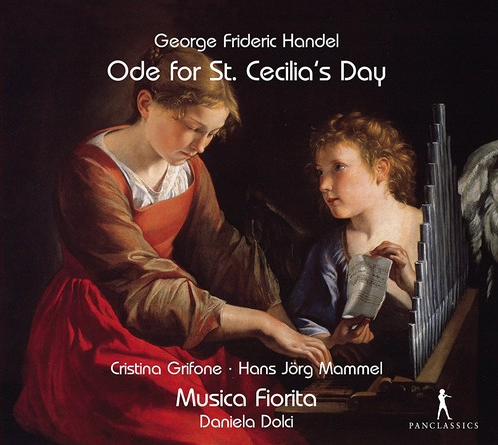 Musica Fiorita, George Frideric Handel: Ode for St. Cecilia’s Day (Pan Classics, 2017).
Musica Fiorita, George Frideric Handel: Ode for St. Cecilia’s Day (Pan Classics, 2017).
Recorded at Adullamkapelle, Basel, Switzerland November 17-21, 2016 in A=415 Hz. http://www.musicafiorita.ch/
From 1683 through 1703, on November 22, St. Cecilia, the patron saint of music would be celebrated with great festivities including a religious Mass, banquets, and a gala concert. Composers whose music was performed during these years include Henry Purcell, John Blow, John Eccles, Daniel Purcell, Giovanni Battista Draghi, and Jeremiah Clarke. It is not known why the tradition ended, but in 1739, it was revived and this time featured music by Georg Frederic Handel. The program included his Alexander’s Feast, which had premiered three years earlier, and a new work with the same title as one composed for these occasions many years earlier by Henry Purcell: the Ode for St. Cecilia’s Day.
Handel composed his work in nine days and employed a poem by John Dryden for the libretto. Dryden was also the author of the text for Alexander’s Feast. The origin and end of the world are described through music, hearkening to a Pythagorean understanding of the foundational role of harmony in all things. Note the text at the beginning of the work:
“From harmony, from heavenly harmony / This universal frame began. / When nature, underneath a heap / Of jarring atoms lay, / And could not heave her head. / The tuneful Voice, was heard from high, / Arise ye more than dead! / Then cold, and hot, and moist, and dry, In order to their stations leap! / And music’s power obey!”
The work features solos by soprano (Cristina Grifone on this recording) and tenor (Hans Jӧrg Mammel), a choir, and a colorful orchestra which features trumpets, transvers flute, and oboe. This present recording is a delight. The vocal work is excellent: dramatic, expressive, and refined. The orchestra under Daniela Dolci plays with great energy, yet at the same time is thoroughly refined in phrasing, blend, and gesture. The recording begins with Handel’s Concerto Grosso, HMV 76, featuring the strings, two oboes and one bassoon. The addition of this work adds to the concept of recreating a St. Cecilia’s Day event in the eighteenth century. This reviewer was captivated by the exquisite work of the strings, particularly cello and violone in the long introduction and then accompaniment in the soprano aria “What passion cannot music raise and quell?” The vocal soloists Cristina Grifone and Hans Jӧrg Mammel display technical prowess, drama and beauty.
The trumpet playing is anything but “loud clangour” as the title of that movement might indicate. It certainly is strong and bold, but at the same time blends perfectly with winds and strings. Jean-Franςois Madeuf and Henry Moderlak play natural trumpets, that is, without venting holes. Madeuf plays a mouthpiece by Bruno Tilz after a mouthpiece which was found with a Bull trumpet in Warwick. Moderlak’s mouthpiece is by Rainer Egger after an 18th century model. The trumpets used are of silver by Robert Barclay (Ottawa), with adaptations by Aron Vajna (Basel) and ornaments by David Edwards after an instrument by John Harris, 1717. Intonation is perfect on the troublesome partials (11 and13) and the sound produced is perfect, one which can only be had through the playing of a truly natural trumpet. Madeuf continues to demonstrate that dedication to historic performance practices will result in exciting and excellent performances. It is with great joy that I highly recommend this recording.
-- James Miller



